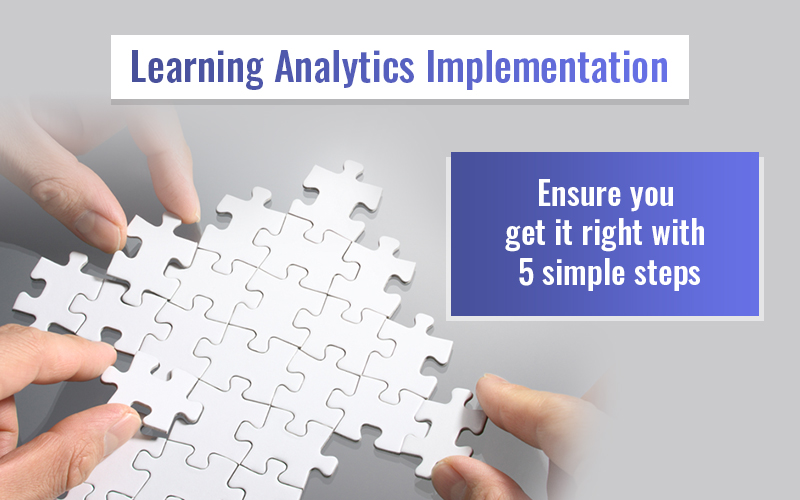Implementing Learning Analytics: 5 Steps to Do it Right

I’ve already invested in an LMS, so why do I need to implement learning analytics? Doesn’t my LMS have customized reporting capabilities?
Yes, it does, but reports produced by LMSs are activity-based and only point out anomalies. The need of the hour is information on what happened, what is happening, and where it is heading. Learning analytics offers actionable insights into trends, not just anomalies; so that learning leaders like you can make predictions and decisions much before a failure occurs.
Have You Started Learning Analytics?
5 Steps for Successfully Implementing Learning Analytics
- Define the objectives
- Tailor metrics to the objectives
- Determine resources for implementation
- Put down a strategic plan
- Develop a monitoring system
By leveraging learning analytics, your organization can better understand whether your training programs achieved the desired outcomes and improved productivity. Analytics can also reveal learner preferences, including which design features and formats they most value. You can use this data to eliminate specific parts of a course (or even entire courses) that are ineffective and are a waste of the organization’s money and time.
But leveraging learning analytics is easier said than done. While some organizations might not have the resources to collect data, others who have them might find it difficult to determine whether they are collecting the right metrics.
Explore the practical implementation guide to eLearning.
Here are 5 best practices you can follow to ensure you get the implementation of learning analytics right.
How to Successfully Implement Learning Analytics
1. Define the Objectives for Learning Analytics
The most important step for successfully implementing anything new is to be able to clearly define why you need to do it. Learning analytics is no different. For instance, learning analytics may be implemented for:
- Research
- Planning
- Evaluation of existing programs
- Tracking and monitoring learning programs
While the objectives may be many, you have to figure out the one which will help achieve the overall business goals of your organization better. That means you will have to ensure the objective aligns with the overall business goals of your organization.
For example, if your organization’s goal is to reduce the number of safety mishaps, the purpose of implementing learning analytics can be to check the effectiveness of existing safety training programs to identify where learners are going wrong or need more help with. In this case, learning analytics can help uncover factors that are hindering effective training that may include outdated or irrelevant content, design inadequacies, or accessibility issues.
2. Tailor the Metrics to the Objective
Now, it’s time to identify key L&D metrics that will help measure progress toward the objective. After all, you don’t want to get bogged down with tons of data that serve no purpose.
In the same example we had just seen, some of the key metrics you could track include:
- View time to find specific slides which learners find difficult to understand
- Time to course completion to track individual learning difficulties
- Assessment scores to evaluate knowledge and skill levels
- Time spent on learning activities, number of posts on discussion boards to measure engagement levels
- Learners’ feedback to check how good the course content is
To measure progress effectively, you might need to combine several of these metrics. For instance, if your organization needs to ensure that a certain number of learners are certified at any given time, then you will have to keep track of:
- Learners who have completed the certification course
- Expiry date of existing certificates
- Progress of the current batch and its expected time of completion
However, these metrics should be tracked over a long period to ensure accuracy.
3. Determine Resources for Implementation
Once you’ve decided on the key metrics that will help achieve your objectives, it’s time to determine your resource capacity for implementation. The fact is, many plans for implementing learning analytics fail because organizations fail to determine their resources.
In particular, there are three things you should look for:
- Technology: Do you have the systems, tools, or software to collect, store, and present your data?
- Skills: Do you have LMS administrators, data-analysts, and IT support executives — who have the required knowledge and experience — to analyze data effectively?
- Data: Do you have access to all the relevant data you want to capture in your LMS or other systems (business intelligence tools)?
4. Put Down a Strategic Plan
Having a plan in place will ensure the implementation process is controlled and headed in the right direction. On the other hand, the chances of the implementation going off track are more in the absence of a strategic plan.
Here are some of the things you should include in your plan.
- Responsibilities of team members
- Every step needed to meet the objectives
- Timeline with different evaluation milestones
- Procedure to review and update
5. Develop a Monitoring System
We all know learning is a process that brings changes over time. So, while capturing data at a certain point can be useful, it provides more insights when taken periodically, at intervals. This essentially means you will have to capture and monitor data at multiple points between milestones.
For instance, if you have an evaluation milestone twice a year, try to gather data every month. That way, you will have more than a single dataset to present to stakeholders, and be able to produce reports that accurately point out progress over 6 months in the evaluation milestone.
Summing it Up!
Implementing anything new is going to be risky if you don’t take the time to evaluate the challenges that you might have to face during the process. However, you can successfully implement learning analytics in your organization if you plan well and take advantage of the resources and people at your disposal. Follow these 5 steps to ensure you successfully implement learning analytics in your organization.
While this was all about implementing learning analytics, knowing about other aspects of learning analytics will help you build a strong case for it. For instance, the types of learning analytics, their functions, benefits, and role in training evaluation.
Here’s our eBook “Learning Analytics 101: The What and the Why” which is a one-stop guide that demystifies learning analytics! Download it now for everything you need to know to begin building a data-driven culture in your organization.



![The Roadmap for Implementing Learning Analytics [Infographic]](https://blog.commlabindia.com/hubfs/Imported_Blog_Media/learning-analytics-implementation-roadmap.jpg)
![The Role of Learning Analytics in eLearning Assessments [Infographic]](https://blog.commlabindia.com/hubfs/Imported_Blog_Media/learning-analytics-elearning-assessments.jpg)
